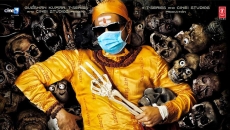What will the future look like?
A few months ago, the world was hit by a virus that has changed the way we live. The world is at war against a strong, unstoppable disease. Sanitizers, masks and gloves are the essential tools in this fight to save humanity. Social distancing, hand washing and sanitizing have become the standard norm. As of May 22, 2020, British Columbia confirmed 2,507 cases of coronavirus disease and 155 deaths.
A total of 2,042 people have recovered with the number of active cases being 310. There are now 41 COVID-19 patients in B.C. hospitals, including eight in intensive care. “The COVID-19 pandemic has been challenging for all of us. It has changed the way we work, learn, and shop, and it’s changed the way we interact with the people around us,” says Patty Hajdu, Canada’s Minister of Health.

"The COVID-19 pandemic has been challenging for all of us. It has changed the way we work, learn, and shop, and it’s changed the way we interact with the people around us,” says Patty Hajdu, Canada’s Minister of Health.
The Canadian government has done a good job in curbing the spread of the virus throughout the country. Not just through proper healthcare, but also by helping people and businesses that have lost jobs or income, with the Canada Emergency Response Benefit and programs like the Canada Emergency Wage Subsidy and loans through the Canada Emergency Business Account. Sadly, along with threatening our well-being, coronavirus has also broken down our economy and caused a massive loss in terms of workforce and production. “Canada, in general, is in the midst of the worst economic downturn it has experienced in decades. The shutdown of non-essential businesses and the physical distancing measures in place across the country to slow the spread of COVID-19 have brought activity in many industries to a near standstill,” says Anita Huberman, CEO of the Surrey Board of Trade. From the outset, B.C. established clear guidance, transparency and an evidence-based approach to fight against COVID-19. B.C. has created a Restart Plan that lays out a series of steps that will protect people and re-open the economy. The province is already on its second phase of the Restart Plan which allows some businesses to reopen with restrictions. As B.C. attempts to bring things back to normal, the pertinent question remains: What will life look like post COVID-19?

"Canada, in general, is in the midst of the worst economic downturn it has experienced in decades. The shutdown of non-essential businesses and the physical distancing measures in place across the country to slow the spread of COVID-19 have brought activity in many industries to a near standstill.” - Anita Huberman, CEO of the Surrey Board of Trade
B.C.’s health sector continues to fight strongly against COVID-19; immense credit and gratitude goes to all the healthcare and essential workers who are putting their lives at risk to stabilize the situation. “Once the World Health Organization declared the Covid outbreak to be a pandemic, the Canadian response was swift in instituting self isolation, shutting down non-essential businesses and travel to contain the spread. By flattening the infection curve, this allowed our healthcare system to not be overwhelmed and effectively utilize our resources to treat patients,” says Dr. Jaspinder Ghuman, M.D., CCFP(EM), Staff ER Physician at Surrey Memorial Hospital, adding that making capacity within hospitals and building testing centers was all ground level work. “We took from the experiences of other countries who were already going through the crisis and adapted. We quickly built tents to triage and test patient presenting to our hospital. We separated our emergency department into potential Covid and non Covid zones, to reduce risk for patients.”

Minster Hajdu is grateful for the care and compassion of health care workers every day, but even more so during a global pandemic. “Their dedication and bravery are getting us through this pandemic, and we owe them a debt of gratitude. We also need to recognize the immense contributions of other front line workers, like those keeping the lights on or helping us put food on our table.” Terra Scheer, who manages communications and stewardship for Langley Memorial Hospital Foundation (LMHF), says, “We are proud to be part of such an incredible team. Every day, we see every member of the staff – from nurses and physicians right down to the security and housekeeping – doing everything they can to help patients and the community.”

“We took from the experiences of other countries who were already going through the crisis and adapted. We quickly built tents to triage and test patient presenting to our hospital. We separated our emergency department into potential Covid and non Covid zones, to reduce risk for patients.” Dr. Jaspinder Ghuman, M.D., CCFP(EM), Staff ER Physician at Surrey Memorial Hospital
Dr. Ghuman, also a Clinical Associate Professor at the University of British Columbia, is impressed by the ingenuity of human beings responding to this crisis. “The ability of our society to maintain essential channels such as the food, and businesses to come together and shift manufacturing towards Personal Protective Equipment (PPE), ventilators and alcohol for sanitizing. Definitely, our healthcare system in Canada was overwhelmed but we were fortunate enough to fare better than many other countries.”
During this crisis, the community has come together to fight the pandemic in unison. Numerous people are helping those in need through donations, supporting local businesses or positive support. The LMHF is overwhelmed by the generosity shown over the past few months. “Langley residents and businesses have stepped up in a big way to ensure our care teams have the resources they need to feel confident and well supported in their role during the local health care response to the COVID-19 pandemic,” shares Scheer. Minister Hajdu continues to urge people to practice physical distancing. “We know it is difficult, but it is necessary. We’ve made great progress in flattening the curve, but we can’t stop now. Together, we will get through this.”

With social distancing being of great importance, will virtual healthcare gain prominence post the pandemic? Dr. Ghuman comments that through virtual care has been around for many years, there really wasn’t a widespread adoption. “However, given the current crisis and improvement in virtual platforms, physicians have been able to continue to provide care in a safe environment. Looking into the future my belief is there will be a role for virtual medicine for certain types of care such as follow up visits that don’t require an in person examination, prescription refills, mental health and care for individuals who have difficulty with mobility. However in-person visits will continue to play a very central role as virtual care will not be able to replace the human contact essential to a patient and health provider relationship.”
According to Dr. Ghuman, the government’s top priorities should be towards ensuring a secure supply of PPE for hospitals and community-based health providers. “Making sure that we have enough capacity to test for Covid infection for contact tracing and serological testing to see who has been infected in the past. Testing, development of new medicines and vaccinations will be crucial in getting society towards normality.” He adds that it is also time to be innovative and utilize new technology such as artificial intelligence in our battle against Covid. “Finally, governments will also need to spend more to increase the capacity of health systems to catch up on all the surgeries and specialist referrals that were interrupted because of the Covid outbreak. This will also require a lot of innovation and use of new technology to make it feasible.”

"School will look very different than it did before spring break – we’ll have smaller class sizes, limited movement between classes, more stringent cleaning and personal hygiene protocols, and new classroom routines including revised seating as we all keep our distance and stay safe,” says Ritinder Matthew, Communications Manager, Surrey Schools.
Due to COVID-19, B.C.’s education sector has had a major transformation. Under the direction of B.C.’s Provincial Health Officer, in-person instruction in public and independent K-12 schools was suspended on March 21, 2020, as a precautionary measure to limit the further spread of COVID-19. “For our district, this announcement came during the first week of spring break so many of our school-based staff were on vacation. We spent the following weeks planning our continuation of learning strategy, which saw the development of resources to support staff and students with virtual and remote learning, including the launch of www.surreyschoolsone.ca,” says Ritinder Matthew, Communications Manager, Surrey Schools. The Surrey School District also organized childcare for the children of essential service workers, and adapted programs to continue supporting some of the more vulnerable learners.
B.C. schools reopened on a voluntary, part-time basis on June 1, 2020, and will eventually return to a full normal in September. Surrey schools will begin a gradual return to in-class instruction using a staged approach. The district will be following the updated health and safety protocols laid out by the B.C. Center for Disease Control for school settings. “So school will look very different than it did before spring break – we’ll have smaller class sizes, limited movement between classes, more stringent cleaning and personal hygiene protocols, and new classroom routines including revised seating as we all keep our distance and stay safe,” informs Mathew. She points out that some students prefer virtual learning, while others miss face-to-face interactions. In June, Surrey district will have a hybrid model that will see classrooms continue with virtual and remote learning, with additional in-class instruction available for families who choose that option. “I think the important factor to keep in mind is that it is ultimately a parent’s decision to send their child to school. We will still be continuing online instruction, and in-class instruction is optional. Parents who choose not to send their child to school will not be penalized.”

"Universities are expecting significant declines in their enrollment numbers, which may in turn lead to service cuts and layoffs. Students are in precarious financial situations, as many will not be able to work like they normally would in order to save up for their tuition.” - Grace Dupasquier, Chairperson-Elect of Alliance of British Columbia Students
Education has gone through a rapid adaptation thanks to the pandemic, and everyone has had to learn how to work with a remote instruction model. COVID-19 has profoundly impacted the post-secondary community. “Universities are expecting significant declines in their enrollment numbers, which may in turn lead to service cuts and layoffs. Students are in precarious financial situations, as many will not be able to work like they normally would in order to save up for their tuition,” says Grace Dupasquier, Chairperson-Elect of Alliance of British Columbia Students.
So will students prefer sticking to online learning? “The feedback we’ve heard from students is that while in some cases online learning has given them a bit of scheduling flexibility, for most, a return to in-person classes is greatly preferred. Most students largely feel that online learning – despite the truly impressive ways instructors and professors have been able to pivot their material to an online environment – is not providing the same value as in-person instruction,” answers Dupasquier who believes things will likely not go completely back to normal until everyone’s safety can be fully guaranteed.

From a university perspective, SFU had to deal with challenges such as transitioning to different ways of learning and working, postponing the in-person Convocation ceremony and honouring it virtually, and cancelling or postponing all other in-person campus events, among others. The university has quickly transitioned to new ways of learning and working in order to prioritize the health and safety of the university community. SFU is offering remote classes over the summer. “In the fall most classes will continue to be delivered through remote methods to provide certainty for students and instructors, safety for those with higher levels of health risks, and access to learning for students who cannot travel to BC at this time,” informs Jonathan Driver, Vice President Academic and Provost pro tem at SFU. If allowed by government and health authorities, and provided that personal health and safety can be maintained, SFU will offer a limited amount of in-person courses and activities in the fall, where the learning objectives cannot easily be replicated through remote instruction.
Huberman believes that for businesses, it will be a new economic paradigm. “They will need to look at physical distancing measures within each business or organizational space, cash flow implications and sustainability, technology and innovation processes, workforce upskilling/reskilling, and supply chain (vendor) needs.” Also, according to parliamentary budget officer Yves Giroux’s report, the federal deficit for the year will likely hit $252.1 billion as a result of the COVID-19 pandemic. This could mean that the future generation will have to bear the brunt of Covid-19’s economic impact. “Canada's Finance Minister has said that there are no plans to increase taxes to pay for the roll out of monetary support programs to Canadians. However, I believe the federal government, like all other levels of government, will need to apply different surcharges to services or re-pay their debt somehow, unless other revenue sources can be found through economic projects that will create jobs,” says Huberman.

With B.C. government’s nod to reopening small businesses and retail sector, Guildford Town Centre (GTC) has implemented a series of preventive health and safety measures, including educating tenants and visitors on respiratory and hand-washing hygiene, hand sanitizer dispensers at designated locations, increased frequency of housekeeping practices in the common areas, and directional signage and floor markers in place to ensure appropriate physical distancing. “We have also paused some of the services available through Guest Services, including stroller, wheelchair and scooter rentals. The health and safety of our visitors, tenants, their employees and their customers are our number one priority,” says Kyla Way, Marketing Director of GTC. The centre’s owner Ivanhoé Cambridge also deployed mitigating measures like rent deferral for the months of April and May for certain tenants most affected by the Covid-19 situation. The retail sector seems to be slowly coming back. “We are seeing traffic increase as our retailers are gradually reopening. All stores won’t be opening on the same day, as retailers have different plans, timelines and resources that dictate when they will open,” adds Way.

Earls Restaurants reopened B.C. locations on May 19, 2020, with enhanced safety measures in place to ensure guest safety and comfort. Some of their safety measures include masks worn by employees at all times and employee health checks before entering the restaurant. Groups will be sat six feet apart with a maximum of six people per table both in the restaurant and on patios. Single use menus will be provided and restaurants will operate at 50 per cent capacity to ensure physical distancing. “We know dining in our restaurants is going to look and feel different for the foreseeable future but we want our guests and employees to know that we’re doing everything we can to ensure their safety. This includes following government regulations and protocol as well as the addition of our own enhanced safety measures,” adds Mark Hladik, Chief Restaurant Officer of Earls Restaurants. With regulations being eased and businesses, schools and other facilities opening in June, Dr. Ghuman states that there’s certainly a possibility that we may have to prepare for a second wave in the coming months. “We must use lessons learned from the first wave to reduce the impact on society. We’ve realized that society can’t afford to be in complete lockdown due to the economic impact. But there are measures that we can take to reduce the infection rate such as physical distancing, wearing masks and practicing proper hygiene.” He believes that the recovery will be slow and the world that emerges will be different.

As B.C. strives to re-strengthen its economy and various industries, we play a crucial role in this progress. No matter what the future looks like, we have the power to change it to the way we want it. By being mindful and supportive of each other via physical distancing, maintaining hygiene and practicing kindness, we can fight this disease together.

COVID-19 impact on airline industry
Since its onset, the impact of COVID-19 has had a devastating effect on Canada’s airline sector. Air Canada saw its operation downsized by over 95 per cent for the months of April and May. “The situation required us to rapidly rethink our business and respond to the fast-changing operating environment to keep the movement of people and goods going wherever possible. Whether it was initially repatriation flights in conjunction with our Federal Government to bring Canadians home from various locations around the world, or maintaining air bridges to all provinces, territories and key international markets, it was vital in our minds Air Canada keep flying throughout this crisis,” says James Howey, Manager, Business Development at Air Canada. Also, within days of the fleet being grounded in late March, Air Canada immediately seized the opportunity to convert seven of their largest Boeing 777 and Airbus A330 passenger aircraft by removing seating in the passenger cabins to enable cargo-loading in the passenger deck, and launching international cargo-only flights to support the flow of much needed PPE, pharma and other commodities into Canada.

"The situation required us to rapidly rethink our business and respond to the fast-changing operating environment to keep the movement of people and goods going wherever possible.” - James Howey, Manager, Business Development at Air Canada
Air Canada is currently offering vouchers with no expiry to passengers for their cancelled flights. “We responded quickly to the evolving situation to where we are today, with several flexible credit options available for travel we made retroactive to March 1, 2020,” informs Howey. Those holding refundable tickets may continue to submit for a refund. For all non-refundable tickets, they may be converted to an Air Canada Travel Voucher for the full amount with no expiry date, which is fully transferable, which means it can also be used by anyone in the family. Or, one may choose to covert the ticket to Aeroplan Miles and receive a 65 per cent bonus
top up.
In response to the COVID-19 situation, Air Canada has led the industry with their newly launched CleanCare+ Program, which lays out the most stringent standards on how they engage with customers every step of their journey from airports through to on board the aircraft. “Measures such as mandatory masks for passengers, temperature screening, hydrostatic cleaning utilizing medical grade disinfectant for our aircraft interiors, seating plans with additional space onboard until June 30, 2020 in Economy Class, amenity kits for passengers that include hand sanitizers and wipes are all new standards to ensure our passengers always feel safe,” informs Howey.
It is Air Canada’s current expectation that it will take at least three years to recover to 2019 capacity levels. “On May 22, we announced our plans to begin rebuilding our global network with additional Domestic, Transborder and International services to nearly 100 destinations for our Summer 2020 schedule. Together with our CleanCare+biosecurity program which is a multi-layered approach and our enhanced goodwill policies should travel plans change, we look forward to safely welcoming customers onboard,” says Howey.







